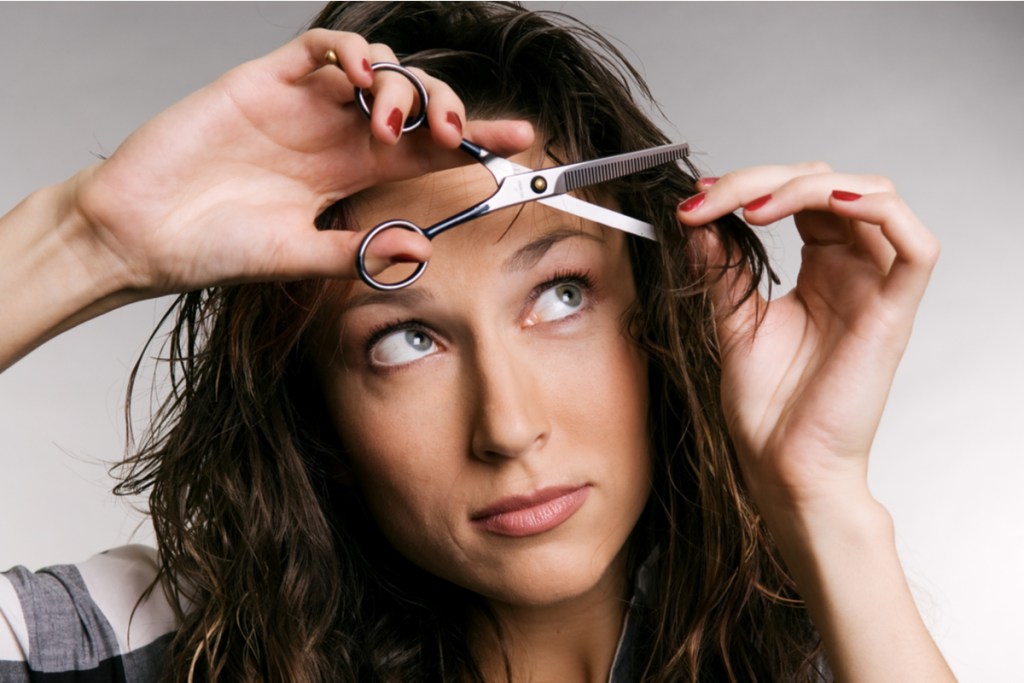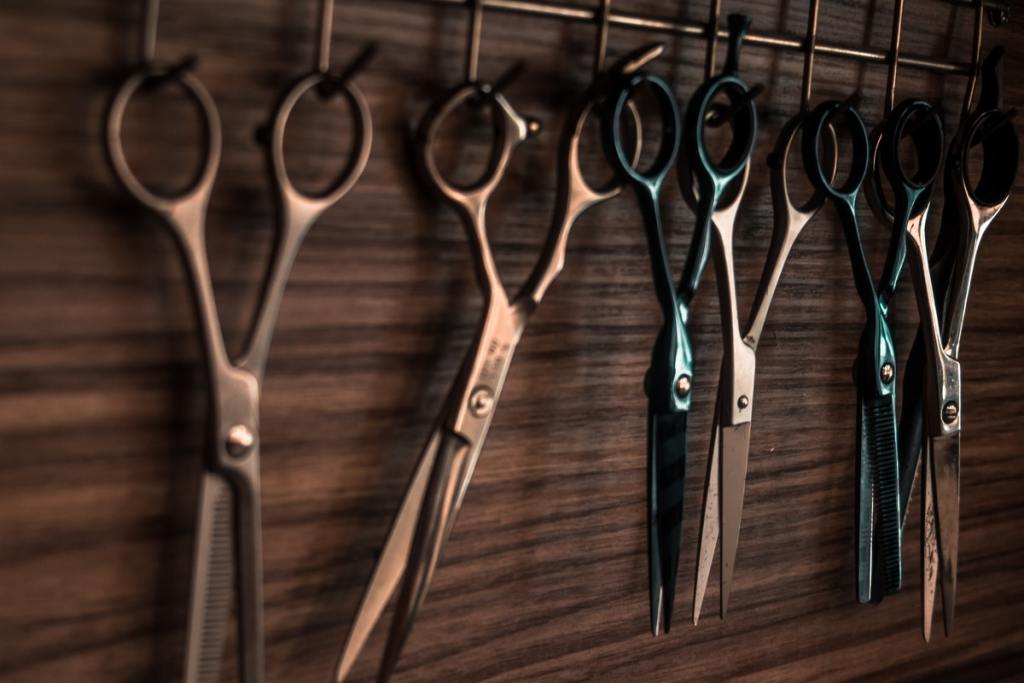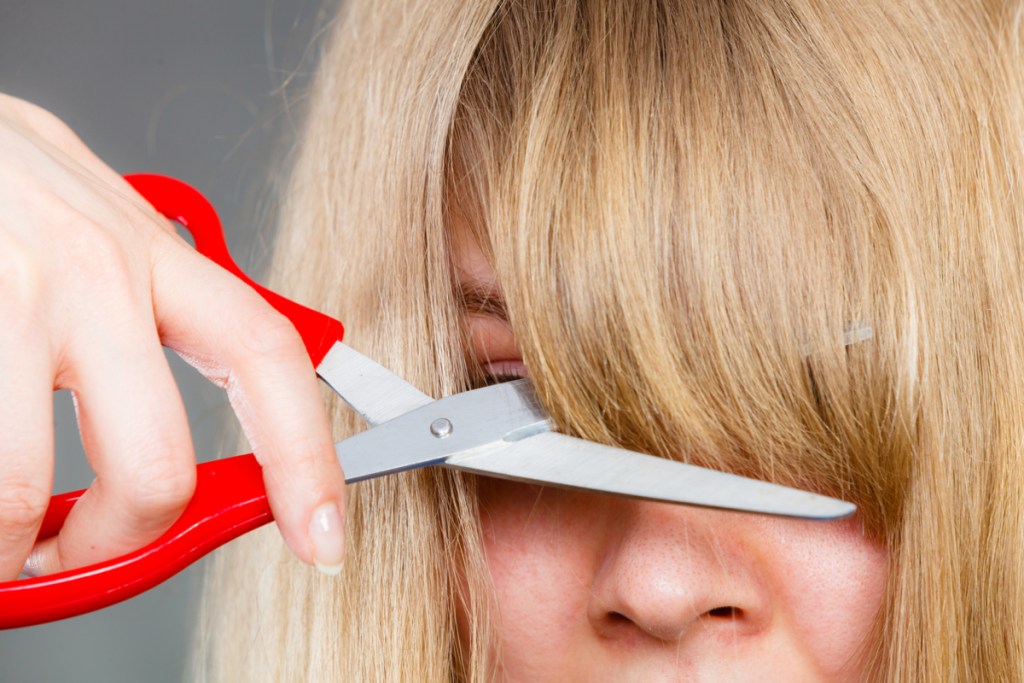We’ve all been there: You’ve gotten so bored with your look that if you don’t do something — and fast — you’re going to scream so loud the neighbors might actually check on you. Okay, that might be a bit of an exaggeration, but cabin fever can be pretty intense, and one of the best ways to battle this boredom is by switching up your hairstyle. Instead of going super drastic and coloring your hair or chopping all of it off, try something a little more subtle.
Getting bangs is a simple way to change up your look. They can grow out easily if you don’t like them, so you won’t be stuck with a less-than-optimal cut for long. But what about cutting them at home? We’ve all heard horror stories about at-home haircuts, but with a few simple tips and tricks, you can safely chop your locks without heading to the salon. Take a deep breath, and let’s go over how to cut your own bangs and not cry about it the next day.

The basics
Before you lift your arm to your head with any sharp object, let’s go over the ground rules. You might be nervous to try to do it yourself, and that’s fine. No matter how tempting, don’t take a few shots to calm your nerves or slam down a cup of coffee. To do this well, you need steady hands and a clear mind.
Have the right tools: All scissors are not created equal, so don’t expect to give yourself a salon-quality cut with your kitchen scissors or nail cutters. Grab a pair that is specifically made to use on your hair. These are designed to give a sharp, precise cut without creating any split ends. If you don’t have any on hand, we recommend ordering a pair of Conair Shears to do the trick.
Keep your hair dry: Just because your stylist cuts your hair when it’s wet doesn’t mean you should as well. Hair shrinks as it dries, so you’ll end up with bangs that are much shorter than you intended. Stylists have years of experience and know just where to chop to give you the perfect fringe. Without this experience, stick to cutting your hair after it fully dries. Another pro tip is to style your hair however you normally wear it. This will give you a better idea about how your bangs will look on a regular day.
Watch videos: From TikTok to YouTube, there are tutorials all over the place on what not to do. Watch them all. Watch them again. It’s so easy to learn from other’s accidents.

Do the cut
Keeping those basics in mind, it’s time to start cutting. Do your research on what bang style goes best with your face shape. If you’re unsure, schedule a consultation with a stylist or ask a friend to determine which look is best for you.
- To begin, part your hair where your head begins to curve from the flatter top of your head toward your forehead. This is where the bang should start. Pull the parted hair forward and put the rest of your hair up in a bun so you don’t make any oopsies.
- To determine where the bang should fall, pull the hair away from your face so you can see your whole forehead. Usually, the bang should end right above your eyebrows. Keeping one finger on your eyebrow as a marker, release the hair, and use the finger to guide where your bangs will end. If you are at all nervous, start with a longer bang — you can always trim shorter.
- Start cutting, keeping your hair between your fingers. Remember, do not cut straight across. Instead, angle the shears and make several small cuts. Cutting straight across in one swoop will leave you with an uneven bang that isn’t long enough on the sides to effectively frame your face.
How did you do? Not bad? If everything checks out and you like what you see, then finish styling your hair. If you are unsure, take a pic and send it to a friend you know will tell you the truth.

Have fun with it
That’s all there is to know about cutting your bangs at home. If you’re unsure what kind of bang to do, go with a nice standard curtain bang, a bang that’s longer on the sides to frame your face. If you don’t love the shape, they’ll grow out pretty quickly and you can tuck them behind your ears. This is definitely the safest option, but don’t be afraid to go with a blunt or choppy bang if you’re feeling bold.
If you totally messed up your bangs, go see a professional. They’ve certainly handled their fair share of less-than-great home haircuts, so they’ll know just what to do. At the end of the day, it’s only hair, and it will grow back. We believe in you, so take your style into your own hands and get ready to debut your bold new look.
BlissMark provides information regarding health, wellness, and beauty. The information within this article is not intended to be medical advice. Before starting any diet or exercise routine, consult your physician. If you don’t have a primary care physician, the United States Health & Human Services department has a free online tool that can help you locate a clinic in your area. We are not medical professionals, have not verified or vetted any programs, and in no way intend our content to be anything more than informative and inspiring.



